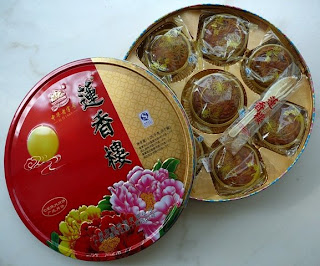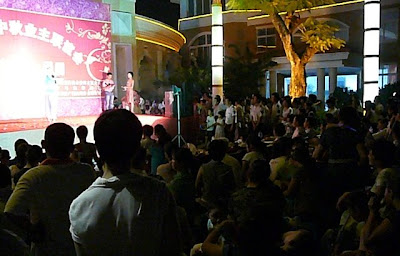 In Zhāngzhōu, as in most Fujǐan cities, you are never far from a tea shop. Walk 100 meters down any residential or downtown street and you will pass one if not several shops selling a selection of teas and usually a range of beautiful tea wares and accessories.
In Zhāngzhōu, as in most Fujǐan cities, you are never far from a tea shop. Walk 100 meters down any residential or downtown street and you will pass one if not several shops selling a selection of teas and usually a range of beautiful tea wares and accessories.Within a few months of arriving in Zhāngzhōu we found ourselves both fascinated and perplexed by the number and of tea shops. In discussing this with our Chinese friend Dr Tony, who is a mine of local information, a figure of more than 1000 tea shops within the city of Zhāngzhōu is revealed. This is a quite startling figure given that the city has only 600,000 residents. And, of course, large quantities of tea is also sold in supermarkets and small convenience stores.

 Tea shops of Zhāngzhōu range from small, simple, owner-operated spaces to very large magnificently decorated shops staffed by teams of immaculately attired young women. As well as shelves and fridges stocked with teas and tea wares, all will have one or more table settings where tea can be prepared and customers can sit, sample and enjoy before they buy. Indeed, tasting is expected and invariably we receive enthusiastic invitations from staff to sit and try their teas. Larger elaborate shops will even have private tasting rooms for their well-to-do clients, but we prefer the open spaces where we can appreciate the full atmosphere and activity of the shop. Indeed we spent many enjoyable Sunday afternoons in this way.
Tea shops of Zhāngzhōu range from small, simple, owner-operated spaces to very large magnificently decorated shops staffed by teams of immaculately attired young women. As well as shelves and fridges stocked with teas and tea wares, all will have one or more table settings where tea can be prepared and customers can sit, sample and enjoy before they buy. Indeed, tasting is expected and invariably we receive enthusiastic invitations from staff to sit and try their teas. Larger elaborate shops will even have private tasting rooms for their well-to-do clients, but we prefer the open spaces where we can appreciate the full atmosphere and activity of the shop. Indeed we spent many enjoyable Sunday afternoons in this way.We enjoyed frequenting tea shops and tasting endless ‘infusions’, however we rarely showed real solidarity with the local tea shopaholics – we didn’t need to. Numerous local friends gave us excellent quality local teas, not just once, but repeatedly. Soon, we had a cupboard full of tea and our inventory grew faster than we could drink it or give it away to friends and family back home in Australia.
 Being Fujǐan the tea most commonly found in the shops and drunk by locals is tiěguānyīn (a variety of oolong tea). They almost always prepare this as gōngfu chá – ‘gōngfu’ means ‘to do things well’ (like the martial art kungfu from which it gets its name) and of course ‘chá’ is Chinese for tea. Preparing gōngfu chá involves using a number of implements: a pot or kettle for boiling the water; a small tea pot either from unglazed clay or a glazed handless, spoutless ‘pot’, a small jug, small tea cups (small so that the tea can be finished with a couple of sips), and a drip tray for spilled water, as boiling water is used in abundance to prepare gōngfu chá.
Being Fujǐan the tea most commonly found in the shops and drunk by locals is tiěguānyīn (a variety of oolong tea). They almost always prepare this as gōngfu chá – ‘gōngfu’ means ‘to do things well’ (like the martial art kungfu from which it gets its name) and of course ‘chá’ is Chinese for tea. Preparing gōngfu chá involves using a number of implements: a pot or kettle for boiling the water; a small tea pot either from unglazed clay or a glazed handless, spoutless ‘pot’, a small jug, small tea cups (small so that the tea can be finished with a couple of sips), and a drip tray for spilled water, as boiling water is used in abundance to prepare gōngfu chá. 



 But given all these tea shops, what do the locals do with all this tea they must be buying? Well, gōngfu chá sets, with the characteristic drip tray and small pot and cups, can be seen everywhere.
But given all these tea shops, what do the locals do with all this tea they must be buying? Well, gōngfu chá sets, with the characteristic drip tray and small pot and cups, can be seen everywhere.
 The locals drink tea at home, in the office, in shops and businesses, and in the parks and gardens. Often, when browsing in small shops, whether for computer accessories, garden items or some mysterious Chinese wares, we are invited to sit and enjoy gōngfu chá by the staff. In business, meetings were often conducted around a gōngfu chá sets on a low table rather than around a more formal meeting table. Just as big business is done on the golf course in some western countries, in Fujǐan it is done at the tea table.
The locals drink tea at home, in the office, in shops and businesses, and in the parks and gardens. Often, when browsing in small shops, whether for computer accessories, garden items or some mysterious Chinese wares, we are invited to sit and enjoy gōngfu chá by the staff. In business, meetings were often conducted around a gōngfu chá sets on a low table rather than around a more formal meeting table. Just as big business is done on the golf course in some western countries, in Fujǐan it is done at the tea table. A popular local pastime, especially on warmer evenings, is to sit and enjoy gōngfu chá with friends in one of the local open-air tea houses. Quickly, our favourite tea drinking venue became one under graceful old trees that fringed a small circular ‘fishing pond’ in a peaceful and historic part of town. We spent many a pleasant evening weekend afternoon there watching a few locals sitting and fishing, but rarely catching. Of course, it was not just about drinking tea – it was a very social place and often we would meet friends there, sometimes to imbibe on beverages somewhat more intoxicating than oolong tea. On a particularly memorable evening the gōngfu chá was just an aperitif – a friend turned up wielding a ‘Jeroboam’ sized bottle of fine red wine (4.5 litre). To compliment the drinking of tea, or other beverages, snacks were readily available and delivered kerbside. At regular intervals a variety of vendors would pedal slowly past on tricycles bearing an inviting range of packaged and fresh snacks. Or, later in the evening, we could stroll over to a BBQ stand with a range of skewed grilled ‘dead things’. Also proffered at the table-side were a range of services such shoe shine, fishing rod rental and more.
A popular local pastime, especially on warmer evenings, is to sit and enjoy gōngfu chá with friends in one of the local open-air tea houses. Quickly, our favourite tea drinking venue became one under graceful old trees that fringed a small circular ‘fishing pond’ in a peaceful and historic part of town. We spent many a pleasant evening weekend afternoon there watching a few locals sitting and fishing, but rarely catching. Of course, it was not just about drinking tea – it was a very social place and often we would meet friends there, sometimes to imbibe on beverages somewhat more intoxicating than oolong tea. On a particularly memorable evening the gōngfu chá was just an aperitif – a friend turned up wielding a ‘Jeroboam’ sized bottle of fine red wine (4.5 litre). To compliment the drinking of tea, or other beverages, snacks were readily available and delivered kerbside. At regular intervals a variety of vendors would pedal slowly past on tricycles bearing an inviting range of packaged and fresh snacks. Or, later in the evening, we could stroll over to a BBQ stand with a range of skewed grilled ‘dead things’. Also proffered at the table-side were a range of services such shoe shine, fishing rod rental and more.But even despite all these opportunities to drink tea, after more than 2 years living in Zhāngzhōu we were still perplexed at how the 1000 or so tea shops can all make enough money to stay in business. So I recently put this question to another of my Chinese friends, Hesheng, who seems to be particularly fond of tea and knowledgeable about all things Fujǐanese – with a smile he replied “Ah, I think there is very good profit in tea …”
Roger Arnold






































